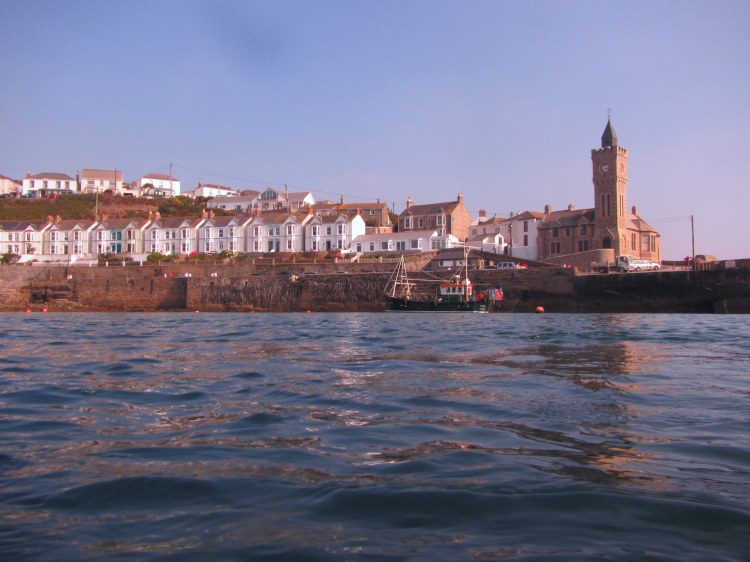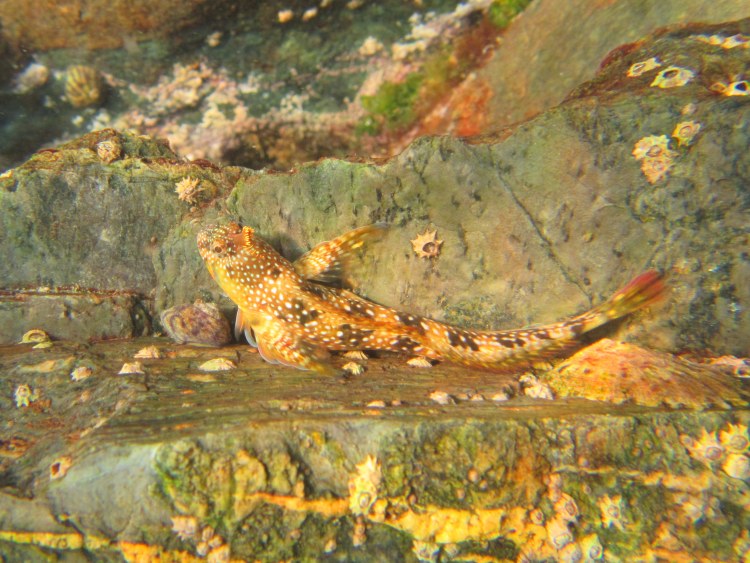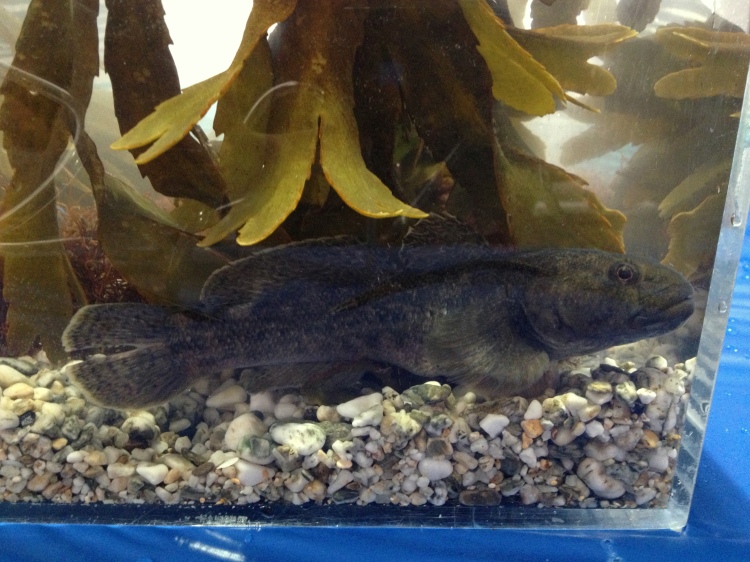I realized this week that I have been blogging on my marine biology adventures for a decade now! Worth a quick self-congratulatory post surely. After living in landlocked places for years (in Germany, the UK and The Netherlands), the move to Cornwall rekindled my love for the seashore. I started this ‘nerd blog’ (with a name no one ever remembers!) shortly after as a way of documenting my adventures for myself, and the occasional stranger stumbling upon it. This had led to some unexpected opportunities, such as recently contributing to the second issue of the magazine ‘Fish – A literary celebration of scale and fin’ with a little piece on snorkeling in Cornwall. I can highly recommend this once-yearly magazine to anyone who is interested in fish – a true labour of love by Nathan Hill of Practical Fish Keeping fame (ahem). The blog topics have changed somewhat over the years, with less focus on rockpooling and my coldwater marine aquarium and more photography-based posts (you can click on specific tags in the cloud at the bottom of the page). The photography has improved (I hope), from using my iPhone and point and shoot camera to a much nicer Olympus micro four thirds camera. The shot above was my favourite from this year (see here for an explanation of what you are actually looking at). Thanks go out to my sister for touching it up in lightroom since (btw, if you are looking for ocean-themed jewellery, please check out her webshop laguna treasures). I think the Links page can still be useful to fellow enthusiasts, although I need to update it (this is for instance a great resource for coldwater marine tank keepers that needs to be added). Anyway, I’ll just say I hope to do a lot more underwater photography in the new year and post it on the blog!
Category Archives: Uncategorized
Trevose Head
 Was last Wednesday the last sunny day of the year? It might well have been and so it was good I had taken a day off to drive to the north coast for some rock pool snorkeling at Trevose Head near Padstow. A beautiful, empty beach at Booby’s Bay led to the low cliffs of Trevose Head. I did not make it that far up the headland as there were some deep gullies and the waves were pounding below. If you slip and fall on your head you could be in real trouble on these solo outings, so easy does it. Like St. Agnes and Fistral at Newquay the pools were dominated by Brown fork tuning weed Bifurcaria bifurcata, one of my favourite seaweeds and not a species I have ever seen near Falmouth. In contrast to my local Castle Beach spot, the coral weed Corallina officinalis was not bleached but a deep purple and growing much more vigorously. I lowered myself in some of the deeper pools and although the viz was not the greatest I instantly knew the trip was worth it.
Was last Wednesday the last sunny day of the year? It might well have been and so it was good I had taken a day off to drive to the north coast for some rock pool snorkeling at Trevose Head near Padstow. A beautiful, empty beach at Booby’s Bay led to the low cliffs of Trevose Head. I did not make it that far up the headland as there were some deep gullies and the waves were pounding below. If you slip and fall on your head you could be in real trouble on these solo outings, so easy does it. Like St. Agnes and Fistral at Newquay the pools were dominated by Brown fork tuning weed Bifurcaria bifurcata, one of my favourite seaweeds and not a species I have ever seen near Falmouth. In contrast to my local Castle Beach spot, the coral weed Corallina officinalis was not bleached but a deep purple and growing much more vigorously. I lowered myself in some of the deeper pools and although the viz was not the greatest I instantly knew the trip was worth it.  I tried to get some overall impressions of the pools. What would be really cool is to try to make panorama photos underwater; I might order an underwater tripod for that! There was some green Ulva, a variety of small red seaweeds and Bushy berry wrack (and a little bit of Bushy rainbow wrack) and Sea oak with the same colour as the tuning fork weed. Many limpets were covered in quite a big variety of seaweeds. Not many shots came out well (due to the strong light, overcast days might actually be better) but it would be fun to do a post just on limpets and their mini-ecosystems of epizoic seaweeds.
I tried to get some overall impressions of the pools. What would be really cool is to try to make panorama photos underwater; I might order an underwater tripod for that! There was some green Ulva, a variety of small red seaweeds and Bushy berry wrack (and a little bit of Bushy rainbow wrack) and Sea oak with the same colour as the tuning fork weed. Many limpets were covered in quite a big variety of seaweeds. Not many shots came out well (due to the strong light, overcast days might actually be better) but it would be fun to do a post just on limpets and their mini-ecosystems of epizoic seaweeds. 

 The pools are teeming with Montagu’s blennies Coryphoblennius galerita, I would say more than 10 per square meter. They are very curious and swim up to you, although the little ones then are so skittish that it is still tricky to get a shot. The fish below was a very good model though, quiff up high. Only through this close-up shot I noticed the strange flaps in the corners of it’s mouth. The blueish spots seem striking but also make for excellent camouflage amidst the coralweed.
The pools are teeming with Montagu’s blennies Coryphoblennius galerita, I would say more than 10 per square meter. They are very curious and swim up to you, although the little ones then are so skittish that it is still tricky to get a shot. The fish below was a very good model though, quiff up high. Only through this close-up shot I noticed the strange flaps in the corners of it’s mouth. The blueish spots seem striking but also make for excellent camouflage amidst the coralweed. 
 Beadlet-, Strawberry- and Snakelocks anemones were common and I also spotted large Dahlia anemones and small Daisy anemones. I saw a large (for the species) Gem anemone Aulactinia verrucosa as well. In the sun, my wide angle wetlens diffracts ligth on the subject which usually is not what you want but resulted in an interesting effect in the second image of the retracting anemone.
Beadlet-, Strawberry- and Snakelocks anemones were common and I also spotted large Dahlia anemones and small Daisy anemones. I saw a large (for the species) Gem anemone Aulactinia verrucosa as well. In the sun, my wide angle wetlens diffracts ligth on the subject which usually is not what you want but resulted in an interesting effect in the second image of the retracting anemone. 

 Finally, the bright red seasquirt Dendrodoa grossularia which I remember seeing before in Falmouth without realising what it was (the squirts are very small and clumped together). A green stalked jellyfish Haliclystus octoradiatus attached to coral weed unfortunately is not in focus but I like the very striking colour contrast. If only I could get my strobe to work and get good macro shots! This has the best north coast rockpooling site so far and I’d love to go back as soon as the weather (and tide) allows!
Finally, the bright red seasquirt Dendrodoa grossularia which I remember seeing before in Falmouth without realising what it was (the squirts are very small and clumped together). A green stalked jellyfish Haliclystus octoradiatus attached to coral weed unfortunately is not in focus but I like the very striking colour contrast. If only I could get my strobe to work and get good macro shots! This has the best north coast rockpooling site so far and I’d love to go back as soon as the weather (and tide) allows! 

diving
Having a diving certificate, being passionate about marine life and having lived in Cornwall for the past few years, it was a bit of a crime to not have been diving (bar a single dive last year). Last week I had the opportunity to join some experienced divers and went for two dives. The first dive was at local spot Silver Steps in Falmouth. We did not go deep (8 meters or so) and could stay in for over an hour. We spotted some cuttlefish (too shy to be photographed), a Greater pipefish Syngnathus acus and two Snake pipefish Entelurus aequoreus. A picture (made with my recent Canon Powershot purchase) of me (looking rather angrily) holding the latter species: For the second dive, we went to Porthleven, west of the Lizard peninsula and sheltered from the easterly winds. It was hard to figure out where to best enter the water; east of the village the cliffs seemed a bit high. In the harbour itself we still had to clamber of some rocks and then had to swim out a bit first to stay out of the way of any passing boats:
For the second dive, we went to Porthleven, west of the Lizard peninsula and sheltered from the easterly winds. It was hard to figure out where to best enter the water; east of the village the cliffs seemed a bit high. In the harbour itself we still had to clamber of some rocks and then had to swim out a bit first to stay out of the way of any passing boats: This dive site was prettier than the first one: there was a larger rock face covered by seaweeds (notably the large Desmarestia ligulata that was completely absent from Silver Steps) with a clean sandy bed beneath (loads of Two-spotted gobies around as always). Lobsters Homarus vulgaris seemed to be relatively common, as we did not particularly look hard but found two individuals (as well as a Spidercrab Maja squinado):
This dive site was prettier than the first one: there was a larger rock face covered by seaweeds (notably the large Desmarestia ligulata that was completely absent from Silver Steps) with a clean sandy bed beneath (loads of Two-spotted gobies around as always). Lobsters Homarus vulgaris seemed to be relatively common, as we did not particularly look hard but found two individuals (as well as a Spidercrab Maja squinado):
 One of my dive buddies pointed out a fish, I enthusiastically but mistakenly chased a small Bib Trisopterus luscus; much to their bemusement they were actually pointing at a Red gurnard Aspitrigla cuculus. It was not shy at all:
One of my dive buddies pointed out a fish, I enthusiastically but mistakenly chased a small Bib Trisopterus luscus; much to their bemusement they were actually pointing at a Red gurnard Aspitrigla cuculus. It was not shy at all:
 Finally, when getting out of the water, amongst the Shannies I noticed a beautiful Montagu’s blenny Coryphoblennius galerita:
Finally, when getting out of the water, amongst the Shannies I noticed a beautiful Montagu’s blenny Coryphoblennius galerita:
Snorkelling at Silver Steps Part II
This snorkel session was also the first time I took a proper look underneath the kelp. Mowing through this forest is very interesting. Besides the gobies and starfish, there are a lot of sponges, bryozoans and hydroids to be seen. A picture from this ‘turf’ with many hydrozoans and a larger erect bryozoan (perhaps an Alcyonidium species?); these are groups I know very little about. A photo beneath that of some worms Bispira volutacornis, very beautiful:
 The kelp is covered by a not so pretty, large, fluffy brown seaweed which might be Pylaiella littoralis (first picture). Large bushes of the slightly iridescent Dictyota dichotoma were also common, this is a species I have never seen in rock pools (second picture). The rocks underneath the kelp are also home to many red seaweeds, notably Sea Oak (I have to get back for some pictures).
The kelp is covered by a not so pretty, large, fluffy brown seaweed which might be Pylaiella littoralis (first picture). Large bushes of the slightly iridescent Dictyota dichotoma were also common, this is a species I have never seen in rock pools (second picture). The rocks underneath the kelp are also home to many red seaweeds, notably Sea Oak (I have to get back for some pictures).
 In the deeper channels there were many Mermaid’s tresses Chorda filum, more than five meters in length. The shallow rocks were covered with Thongweed Himanthalia elongata and Grape pip weed Mastocarpus stellatus with assorted epiphytic tufts of fine red seaweeds.
In the deeper channels there were many Mermaid’s tresses Chorda filum, more than five meters in length. The shallow rocks were covered with Thongweed Himanthalia elongata and Grape pip weed Mastocarpus stellatus with assorted epiphytic tufts of fine red seaweeds. 
“onderzeesche landschappen”
Thus the old Dutch spelling of “Undersea Landscapes” (the English word ‘landscape’ comes from the Dutch word ‘landschap’ btw). I bought some Liebig Cards online; these free collectible cards were supplied with stock cubes and included many biology-themed sets. Besides this set (1936), I also found a seaweed set (1937, in French), cool!

Science in the square
I helped out last Friday at the University of Exeter – Cornwall Campus event ‘Science In The Square’ (see for a short description my work blog ‘coastal pathogens‘). Briefly, the aim was to set up several small plastic trays and tanks with interesting local rock pool creatures and explain some fun facts to the general public (specifically kids). For instance, in one exhibit showing amongst others coralline algae, star ascidians and barnacles you had to guess which organisms were plant and which were animal (glossing over the fact that algae are not technically plants but OK). In another display (‘who’s the daddy’) we explained that it is the males in worm pipefish that are pregnant, not the females. In another display we explained that tunicates have larvae with a tail and spinal chord and that they are evolutionary more closely related to us than are for instance crabs, snails or starfish, something that is not very obvious when looking at the adults:
The star ascidian Botryllus schlosseri. (For some pictures of the related colonial ascidian Botrylloides leachi, see a previous post.) We had a couple of small tanks filled with a variety of animals and seaweeds:
A Giant goby Gobius cobitis, first time I saw one, almost 20 centimeters, quite impressive!











